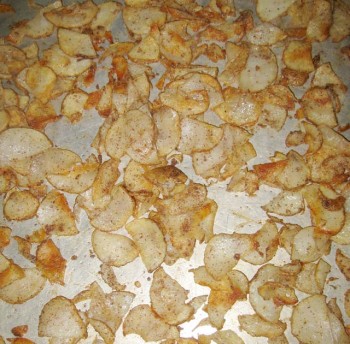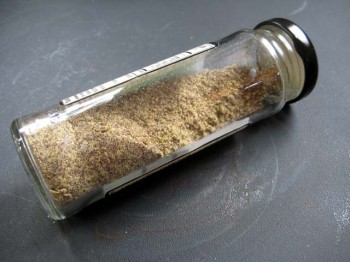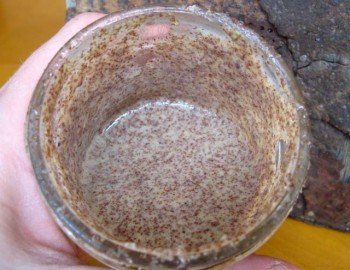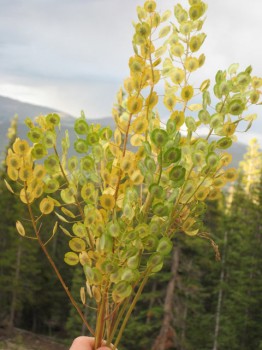
“They’re practically potato chips!” Gregg exclaimed, helping himself to more of the thin-sliced, seasoned, golden-brown oven-fried potatoes until they were gone. I’m not sure which enthralls him more—my recent food inventions, or the fact that I am cooking at all.
Now that I can stand up on my own two feet (after 5 weeks off I am now to start putting weight on my injured leg), it is a joy to be in the kitchen. I cook, I clean; I must be a housewife.
The chips didn’t come out as crunchy as I’d hoped. I did them on a cookie sheet in the oven because I didn’t want to deep fry, although online recipes say to use a rack so the hot oven air can circle them entirely. Then there’s a bit, too, about flipping them manually, with which I didn’t want to bother.
So, I used a food processor to slice the potatoes fine, stirred in a mixture of olive oil and wild mustard, and stuck them in the oven on a greased cookie sheet at 350 degrees for an hour, unsticking and stirring with a spatula occasionally. The ones that turned golden were crunchy indeed, the others just a bit chewy. It was enough to ensure all were eaten in one sitting regardless.

Wild Pennycress Mustard
I’m such a big fan of John Kallas these days, having obtained his 2010 book, Edible Wild Plants: Wild Foods from Dirt to Plate. I’ve wanted to make wild mustard from seeds for ages and there it was, an entire section devoted to “Pungent Greens” of the family Brassicaceae, including several recipes for making mustard from seeds.
The dried pennycress (Thlaspi arvense, Brassicaceae family) seeds in my closet are from two autumns prior—the product of an old obsession and simply begging to be eaten. I ground up a big batch in my favorite new toy, the spice grinder (which is basically just a second coffee grinder) and put it in a spice jar where it looks very much like a real, honest-to-goodness spice you might buy from the store.
Following Kallas’ cautions that homemade wild mustards can be very spicy, I added sugar, vinegar, water, and flour in sparing amounts, sort of a hodgepodge combining aspects of the recipes he puts forth in his book. Somehow I managed to use apple cider vinegar instead of the intended wine vinegar, however, so my mustard ended up extra sweet while also hot.

“It looks like mustard!” Gregg exclaimed, turning the jar over in his hand to guess at what I’d made. “It tastes like mustard!” he shouted after dipping a finger into the jar. Apparently wild mustard is as exciting as potato chips.
Foraging Wild Mustards
You can’t go wrong getting the low-down on wild mustard foraging from Kallas’ book, which covers field mustard (Brassica rapa), wintercress (Barbarea vulgaris), garlic mustard (Alliaria petiolata), and shepherd’s purse (Capsella bursa-pastoris).
And, the late-season seeds are only part of it. Mustard greens are good too. Here at 11,000 feet outside of Fairplay, Colorado, the pennycress (T. arvense) produces its pepper-garlicky fresh leaves long into fall, some of which can even be dug from under snow. The first time I ate spring pennycress rosettes was after a year of observation, as many plants start out with similar rosettes. We also have peppergrass (Lepidium sp., Brassicaceae family) here, though I think both mustards came to our backyard via a shipment of topsoil from parts lower.

I collected my pennycress seeds from light brown, dry plants in fall, stripping their seed-laden, papery round pods into a collecting container, and then later separating the chaff by rubbing it between my hands. Then I used Gregg’s tap-the-backside-of-a-slanted-cookie- sheet method to winnow out the seeds. It’s not a perfect science, but I discovered yesterday that the spice grinder takes care of the remaining unwanted non-seed bits like a charm.
A Tall Order
“If you could make potato chips all the time then we could stop buying them!” Gregg announced excitedly later that same evening, after the oven-fried spuds had disappeared.
Here we go again, I thought. But no worries; I’ll try to get right on that.

looks fantastic- we love those mustards, and have also seen shepherds purse save a life from internal bleeding, powerful stuff- but totally safe eaten in human amounts- cheers, rico
Mr. Gregg’s comments always crack me up! Hello, G!
Pennycress Q – we’ve got it coming up here in MI in the spring (mine looks near-identical to yours, picked yesterday). The plant looks like mustard (and is growing in a fallow field with enormous clover plants), but I’m wondering if I might be picking something else.
Thoughts?
@Crystal: Well, I looked through most of my wild edible books and most don’t say much about field pennycress. Cattail Bob Seebeck reports “many” lookalikes when immature, but when mature, only peppergrass (Lepidium sp.), which is also an edible mustard. Cattail Bob’s book is specific to the Rocky Mountain region, however, even though some of the plants are found in a broader area.
Pennycress IS found throughout the US. It is also known as “stinkweed.” The only other plant I can think of that it looks like is shepherd’s purse, also an edible mustard, but the seedpods are heart-shaped.
Was the pennycress you collected mature? Does it have the flat, notched seedpods? It’s very distinctive that way. The young, immature plants are harder to distinguish, in my opinion. I could post some pictures of those on my Facebook page if you need them. Let me know.